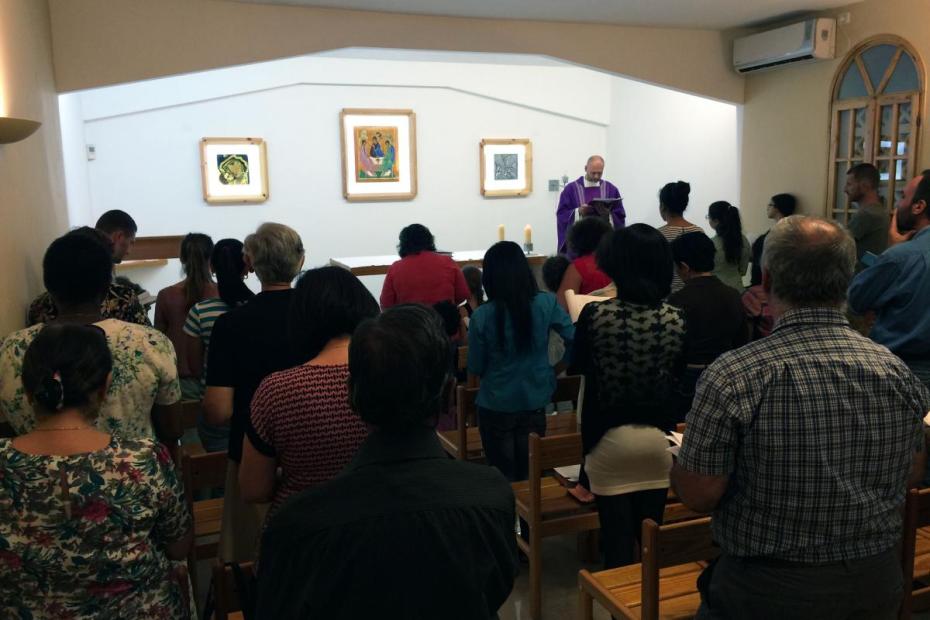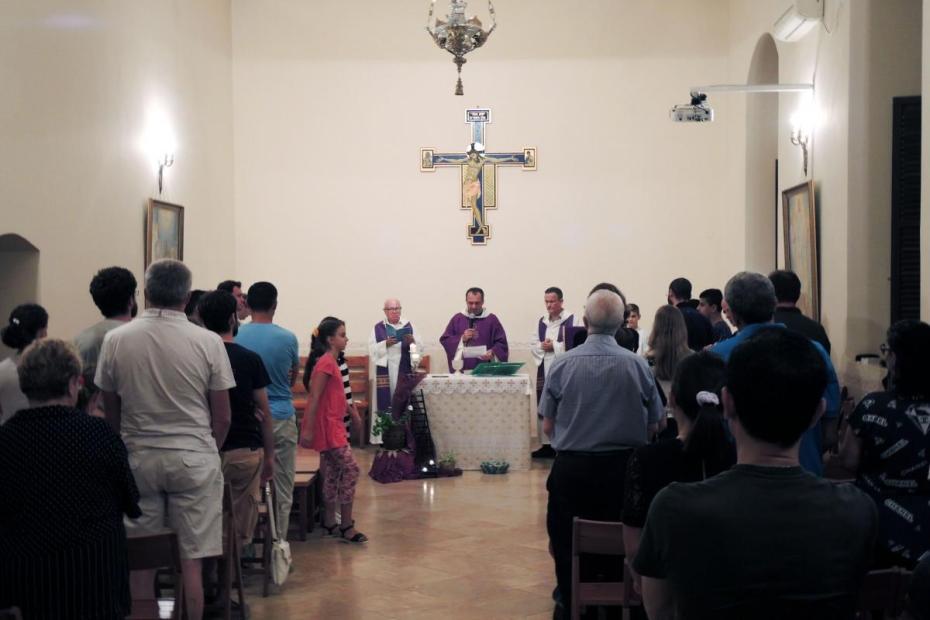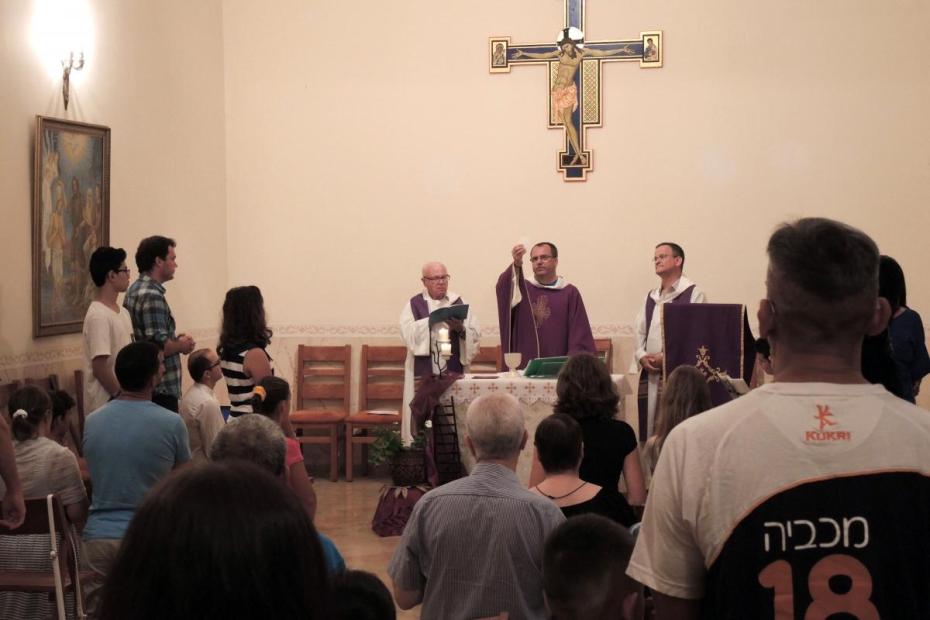While Catholics and Jews share an ancient common heritage, and early Christianity was framed out of the same conceptual world as Judaism, there are not a great many ways that Catholic practices deliberately adapt to Jewish ones in Israel. More precisely, we could say that there are hardly more parallels between Jewish and Catholic daily practice in Israel than there are elsewhere in the world. Catholics in Israel do not normally, for religious reasons, observe kosher dietary rules or similar aspects of halakic law. Many Catholics celebrate feasts with Jewish friends out of respect or friendship, and even find these meaningful without regarding them as integral to their own practice. Out of courtesy they may follow kosher rules when dining with friends. Catholics don’t wear a tallit or tefillin to pray, or daven, or require a minyan for prayer. Though interviewees did indicate that a small number of Catholics are drawn to some of these observances alongside Catholic practice, these are discouraged by clergy.1
Catholics do bury their dead immediately after death, without a wake, as is common for Jews and Muslims, but do so with otherwise Catholic rituals. Mourners do not come together for a meal or gathering around the funeral services, as is common in many Catholic societies. Other elements of a funeral service often vary according to the cultural background of the families, whether they come from France or India or the Philippines or Italy.
The one area where there are deliberate efforts at inculturation is in the liturgy, though this has been done attentively and cautiously. From the early years of the Hebrew-speaking Catholic community as an ecclesial entity, the clergy here were allowed and even encouraged to think carefully about inculturation. In 1957, long before the Vatican II enabled the celebration of the Mass in the vernacular, Pope Pius XII gave the community permission to celebrate the liturgy partly in Hebrew. Some church leaders wanted to develop a distinctive Hebrew-style liturgy that had a similar status as that of the rites in the Eastern churches, but that has not been achieved. There are still efforts to thoughtfully inculturate the liturgy, though this is approached with a sense that good inculturation takes time. Even as many desire such inculturation, some Hebrew-speaking Catholics are eager instead for a liturgy that takes them away from their everyday Jewish worlds.
The most obvious connection to the Jewish world is the fact that the Mass is celebrated in Hebrew. The Hebrew language, while not exactly the same as Jesus’ own Aramaic, evokes worship in the Church’s first century in an unusual way. It also makes more obvious an instance when the language of Catholic liturgical prayer explicitly references Jewish prayer. In the Eucharist, at the offertory prayer, Hebrew speakers hear a variation on words they would hear in Hebrew at the Jewish sabbath blessing, and often at synagogue prayers. “Baruch atah Adonai, Eloheinu melech haolam,” “Blessed are you Lord God of all creation," the synagogue prayers begin. “Baruch atah Adonai, Eloheinu melech haolam, hamotzi lechem min ha-aretz,” (“Blessed are you Lord God of all creation, who brings forth bread from the earth”) and “Baruch atah Adonai, Eloheinu melech haolam, borei p'ri hagafen” (“Blessed are you Lord God of all creation, who brings forth the fruit of the vine”). A liturgy in French or Spanish or any other language has the same parallel, but the Jewish linkage is obscured in translation.2
Another use of language can be powerfully impactful. In place of the Greek term “Christ,” Hebrew-speaking Catholics use the Hebrew word for “Messiah.” Hence, “the Peace of Christ” at Mass is “Shalom HaMashiach,” “the Peace of the Messiah be with you.”
The liturgy is adapted in significant ritual ways: The first is the lighting of candles at the altar after the entrance at Sunday Mass and daily during Advent, by a woman congregant who prays a blessing that begins, “Baruch atah Adonai, Eloheinu melech haolam...” Priests there insist that it is not intended, as many lay people perceive, to copy the Shabbat prayers, when women light candles and recite a benediction beginning with the same words before the Shabbat meal, during which a blessing of bread and wine is traditionally done by men. Rather, they intend it to signal that the Mass brings together the Old and the New, symbolized by the two lit candles.
Scripture is read in longer form than is standard in the lectionary, to give its fuller context and to respect Jewish tradition. Whereas the lectionary used in the Latin Church often omits sections of a passage, (e.g. selecting from Psalm 80 verses 1-7 and 17-19 as a passage), in the Hebrew-speaking Church the whole passage is read. Moreover, it is read in biblical Hebrew, untranslated into modern Hebrew. This honors the Jewish commitment to leave the text as it originally was, and to study and understand and interpret from the original. Kehillot thus often sponsor classes, or have handouts to help people prepare for readings that will be hard for them to understand.
The purification of the hands at Mass occurs before the benediction of bread and wine, because that is its place in Jewish tradition. Matzo, the Jewish unleavened bread of Passover, is used instead of hosts. In a nod to the Eastern liturgical tradition, the greeting of peace is passed from the altar outwards.
Music
Music is the one aspect of liturgy that is probably the most thoroughly inculturated. Hebrew-speaking Catholics have composed their own songs, ones whose melodies would not stand out as foreign to contemporary Israeli Jews, but whose lyrics are Christian. A number of recordings of kehilla music are accessible from this page.
Time
Life in Israel, even in secular cities, is organized by the Hebrew calendar. Shabbat — the Jewish Sabbath — begins as it did in Jesus’ lifetime, at sunset Friday evening, continuing through sunset on Saturday. Sunday, the day Christians celebrate as the Sabbath, occurs on the day that in Israel is the first day of the work week. In Jerusalem in particular, the dates can create a bit of discordance, since almost everything in the city stops for the duration of Shabbat, beginning at mid-afternoon on Friday. In Tel-Aviv and many other cities, the effects of Sabbath are less apparent, but probably as much observed as Sunday is elsewhere in the Christian world. Things at least slow down that day, whereas Sunday is a busy work day. “Sunday” masses, then, are as likely to be held on a Saturday evening as on Sunday. A few “Sunday” masses are even on Friday evening.3 In some places this is of necessity. Buses stop on Shabbat in Jerusalem. Even in secular cities, it helps. People work on Sunday, so masses on Sunday are almost always in the evening after work.
Adaptation to the Hebrew calendar takes place in two other interesting ways. In the Hebrew-speaking Catholic Church, Advent is lengthened to begin at a time that is closer to the beginning of the Jewish New Year. In the Latin Church, Advent begins the Church’s liturgical year. In Judaism, Rosh Hashanah is the beginning of the new year. For 30 years now in Jerusalem, and more recently in other Hebrew-speaking Catholic churches, the Church celebrates the “Great Advent,” which aligns its start to the Jewish holiday of Simchat Torah, the end of the annual Jewish cycle of Torah readings at the end of Sukkot. Typically this alignment means that Advent begins in early October, making it more than twice as long as is typical elsewhere. During this time, readings from the Pentateuch are used as the first reading to follow chronologically the great figures of the Hebrew Bible who Christians believe prepared for the coming of the Messiah. From Rosh Hashanah — which for Jews marks the new year and the creation of Adam and Eve — until the Great Advent, the community celebrates a liturgy to honor God as Creator. 4
In the Latin Rite during the seven weeks of Easter, to signal that we’ve passed from the Old to the New, the Church does not read the Old Testament. In Israel, the Hebrew-speaking community insists on reading from the Old Testament throughout this time. They cannot read the entirety of the Pentateuch, but the daily readings are taken in a consecutive reading of the Pentateuch from Exodus 12 to the end of the Pentateuch, and it parallels what the Latin Church reads, which is the Acts of the Apostles. While Acts shows the Church spreading and growing, the Hebrew-speaking community focuses on the story from the Pentateuch about how Israel spread and grew until it came into the land.
- 1A tallit is a shawl used for prayer. Tefillin are phylacteries, small black containers containing scripture passages that observant men and boys strap to their heads when praying. To daven refers to praying Jewish liturgical prayer, and to the bowing movement one makes constantly while doing so. To gather in a minyan refers to the quorum of 10 men required for synagogue prayer.
- 2The obviousness of the connections for those who hear them regularly could be overstated. One interviewee thought that few Israeli Catholic worshipers had much consciousness of the parallels, though he said that he encountered Jews who had attended Mass with him and who were taken aback at linguistic parallels and use of psalms. The Jewish and Catholic prayers do not end in the same way, since the prayers as adapted by Catholics refer to the bread and wine as gifts “we offer you.” The relevant parallels in the offertory prayer in English are “Blessed are you, Lord God of all creation, for through your goodness we have received the bread we offer you: fruit of the earth and work of hymn hands, it will become for us the bread of life” and “Blessed are you, Lord God of all creation, for through your goodness we have received the wine we offer you: fruit of the vine and work of human hands, it will become our spiritual drink.”
- 3The schedule of Hebrew speaking Masses and Masses in languages that serve migrant and refugee communities is here.
- 4An article describing the order of commemoration is here.


